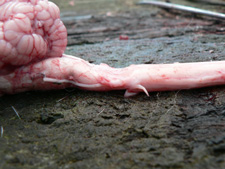Correct vaccination technique avoids losses
Almost all injections administered to sheep should be given high up in the neck. They should be given into the correct tissue as advised on the label (i.e. intramuscularly or subcutaneously).
Needles and injection equipment should be frequently disinfected and maintained in good working order (needles should be sharp and replaced frequently). The product should be stored, administered and disposed of according to label directions.
This applies particularly to vaccines, the injections that are most frequently administered to sheep.
Scabby mouth vaccine is the only product routinely used that should be given other than high on the neck. For all other injections, avoid administration in the brisket, cheek or hind leg (or elsewhere).
In one recent incident, an abattoir had to condemn the loin chops from a line of lambs who had been improperly injected in the loin, because of carcase damage (in the most expensive cut of lamb). Incorrect injection technique can result in unsightly abscesses in valuable meat cuts, which need to be trimmed at the abattoir, resulting in downgrading of carcase value.
This is the reason for the recommendation to administer injections high on the neck.
Dr Elizabeth Ferguson, Livestock Veterinarian at Zoetis, suggests: 'to minimise site reactions, producers should select the appropriate needle. We recommend a 6 mm (¼ inch) needle for lambs, and a 12 mm (½ inch) needle for sheep in wool, always ensuring that the needle is kept clean and sharp'.
'It is also vital that they select the appropriate injection route and site—for Gudair®, that is subcutaneous, and high on the neck, just behind and below the base of the ear. For correct vaccination technique, ensure that the bevel of the needle is attached to the applicator so that it enters parallel to the skin surface and is injected under the skin, not into the top layers of muscle, to avoid lumps and carcase damage.'
'Finally, to minimise site reactions with Gudair especially, it is important to restrain sheep adequately during vaccination. This is another reason why we advise vaccinating lambs with Gudair at marking.'
Of particular note is the condition referred to as 'Gudair staggers', when the oily Gudair vaccine works its way through muscle layers and into the spinal cord, producing compression on the spine and causing the sheep to lose coordination in its hind limbs.
In some cases, this does not show up until many years later; at other times, the first lambs affected are seen shortly after marking and vaccination.
To avoid losses, it is important to correctly place the injection in the subcutaneous tissue just below the skin, not into muscle, by using short needles, with only 6 mm (¼ inch) being inserted into the animal. Pay attention when using safety vaccinators, because sometimes they are sold with cattle-length needles, which leave too much needle exposed when the safety shroud is retracted.
Also, take care to align the bevel parallel with the skin, so that the tip does not go too deep when giving subcutaneous injections.
Elizabeth added: 'responsible use of vaccines, including Gudair, is important to minimise site reactions and reduce the risk of accidental self-injection. This includes using appropriate vaccinators. For Gudair, we recommend the Sekurus® applicator because of its additional safety features. The front shroud on this applicator has been designed to tent the sheep's skin to help deliver the vaccine subcutaneously'.
'It is also a good idea to check the flock regularly after vaccination to monitor for abscesses that could lead to potential fly strike. Use fly preventive treatments if the sheep are at risk.'

Alt: Photo of the top of a sheep's spinal cord and part of the sheep's brain
Caption: Indentation in a sheep's cervical spinal cord due to an abscess caused by incorrect administration of Gudair
If staggery sheep over the age of 2 years are noticed, they may be suitable for investigation under the National Transmissible Spongiform Encephalopathies Freedom Assurance Program (NTSEFAP). In most instances, such signs in sheep are not amenable to treatment, so prompt euthanasia is warranted.
Investigation by your private veterinarian or department animal health staff, through sampling the brain at postmortem examination, will assist Australia's ongoing efforts to demonstrate the country's freedom from scrapie, the sheep version of bovine spongiform encephalopathy ('mad-cow disease').
Both producers and veterinarians can receive subsidies for investigating cases such as Gudair staggers in older sheep:
- $100 to the producer for each sheep's brain tested
- $200 to the veterinarian to assist in covering costs.
For more information, contact your local animal health office or your nearest private veterinarian.
Robert Suter, Statewide Veterinary Officer—Sheep